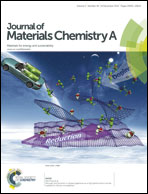Synthesis and photovoltaic properties of two-dimensional benzodithiophene-thiophene copolymers with pendent rational naphtho[1,2-c:5,6-c]bis[1,2,5]thiadiazole side chains
Abstract
A series of new two-dimensional copolymers, PBDTT-TABT, PBDTT-TANT and PBDTT-TSNT, with conjugated benzodiathiazole (BT) or naphthobisthiadiazole (NT) side chains were successfully synthesized and characterized for high performance polymer solar cells (PSCs). The NT unit showed a stronger electron-withdrawing ability and a larger conjugation than the BT unit, which induced a stronger ICT process between the benzodithiophene (BDT)-thiophene (T) backbone and the conjugated side chain for NT containing copolymers. As a result, PBDTT-TANT and PBDTT-TSNT showed lower-lying bandgaps and more red-shifted absorption than PBDTT-TABT. The alkylthio modification effect of conjugated side chains was also investigated in this work. This effect showed a positive role in lowering the HOMO energy level, and a negative role in elevating carrier mobility and molecular stacking properties in our two-dimensional polymeric systems. Bulk heterojunction (BHJ) PSCs were fabricated using these copolymers as the donor materials to evaluate their photovoltaic properties. The PBDTT-TABT, PBDTT-TANT and PBDTT-TSNT devices exhibited PCEs of 4.60%, 5.65% and 4.01%, respectively. In spite of the Voc values, the highest Jsc, FF and PCE were achieved for the PBDTT-TANT device, which was attributed to its red-shifted absorption, improved carrier mobility and well-defined phase separation. It is interesting that the Jscs, FFs and PCEs of all these devices were elevated significantly when made using the solvent vapor annealing (SVA) method. The THF–SVA process would provide a driving force to facilitate the formation of a much more well-defined surface morphology, resulting in the enhanced Jsc and FF values. The PBDTT-TANT device showed the highest PCE of 8.04%, which is the top efficiency for this type of two-dimensional copolymer with donor (D)–donor (D) polymer backbones and donor (D)–acceptor (A) conjugated side chains. Our design strategy would give an instructive guide to developing high performance two-dimensional polymer donors to be used in organic photovoltaic applications.
![Graphical abstract: Synthesis and photovoltaic properties of two-dimensional benzodithiophene-thiophene copolymers with pendent rational naphtho[1,2-c:5,6-c]bis[1,2,5]thiadiazole side chains](/en/Image/Get?imageInfo.ImageType=GA&imageInfo.ImageIdentifier.ManuscriptID=C5TA07205K&imageInfo.ImageIdentifier.Year=2015)

 Please wait while we load your content...
Please wait while we load your content...